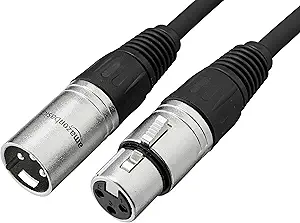The Ultimate Buying Guide for XLR Cables
Overview
XLR cables are essential for connecting microphones and other audio equipment to a mixing console or amplifier. But with so many types and brands of XLR cables available, it can be overwhelming to choose the right one for your needs. This buying guide will help you understand the different types of XLR cables, key considerations, features, prices, tips, and FAQs to make an informed purchase decision.
Types
1. Standard XLR Cables: These are the most common type of XLR cables, featuring three pins for balanced audio transmission.
2. Mini XLR Cables: These are smaller versions of standard XLR cables, commonly used for connecting lavalier microphones and other small audio devices.
3. AES/EBU XLR Cables: These are designed for digital audio transmission, featuring two pins for balanced signal and two additional pins for data transmission.
4. DMX XLR Cables: These are used for lighting and stage applications, featuring five pins for transmitting lighting control signals.
Key Considerations
1. Cable Length: Choose the appropriate cable length for your needs, considering the distance between your audio equipment and the mixing console or amplifier.
2. Cable Gauge: Thicker cables have lower resistance and better signal integrity, but they can be less flexible and more expensive.
3. Connector Type: Choose the appropriate connector type for your audio equipment, such as male or female XLR connectors, or TRS connectors.
4. Cable Construction: Look for cables with durable and flexible construction, such as braided shielding and high-quality insulation.
5. Audio Equipment Compatibility: Ensure that the XLR cable is compatible with your audio equipment, such as microphones, mixers, amplifiers, and speakers.
Features
1. Shielded Cables: These cables have a layer of shielding that reduces electromagnetic interference and noise.
2. Gold-Plated Connectors: These connectors provide better conductivity and corrosion resistance.
3. Locking Mechanisms: These mechanisms prevent accidental disconnection of the XLR cable.
4. Colored Cables: These cables help distinguish between different audio channels or devices.
Prices
XLR cable prices can vary depending on the length, gauge, connector type, and brand. Standard XLR cables can range from $5 to $50, while high-end cables with advanced features can cost up to $100 or more.
Tips
1. Test the XLR cable before use to ensure proper signal transmission and no noise.
2. Use cable ties or velcro straps to organize and protect your cables.
3. Avoid running XLR cables near power cables or other sources of electromagnetic interference.
4. Invest in high-quality XLR cables for better audio quality and durability.
FAQs
Q: What is the difference between balanced and unbalanced audio cables?
A: Balanced cables have three conductors for transmitting two audio signals and a ground, while unbalanced cables have two conductors for transmitting one audio signal and a ground. Balanced cables provide better noise rejection and signal integrity.
Q: Can I use XLR cables for other audio equipment besides microphones?
A: Yes, XLR cables can be used for connecting mixers, amplifiers, and speakers, among other audio devices.
Q: What is the maximum length of XLR cables?
A: The maximum length of XLR cables can vary depending on the cable gauge, signal strength, and environment. Generally, XLR cables can transmit signals up to 100 meters (328 feet) without significant signal degradation.
Q: How do I clean XLR cables?
A: Use a soft cloth or cleaning solution to remove dirt and dust from the XLR cable connectors. Avoid using abrasive materials or excessive force that can damage the connectors or cables.














